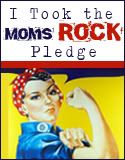- Join NewBaby.com
- Feed your RSS in your profile and put your blog URL (website or all sites) in the about you with info about YOU.
- Add your photo to your profile.
- Add a Friend: NewMomsOnline (that's me)
- Go to our Linky Love page and grab a badge for your site and install it
- Fill out the link back form from us to your site / blog so it shows up in our directory
- Write a blog (short or long) on why you're ready to jump in front of a camera and vlog... it's easy - just think of your pictures animated. Lot's of our Mom's start off a bit nervous and in no time are rocking it like a Movie Star
Oh... here is some background on why we are doing this...
NewBaby.com is the first online community focusing on Mom's by providing video blogs from opinions to expert advice. We have been helping mom's who want to go from blog to vlog... by giving them Flip Video Cameras (that we have been buying... boo, not donated by Flip!).
Why do we push video so much?? Video is the next big wave and if you read all the new media press like I do, you see things like this:
Businesses Embracing Online Video Will Fuel The Web's Revolution
IF VIDEO KILLED THE radio star, online video will surely kill the static Web.
Video is poised to permeate the Web in a way that goes far beyond YouTube's user-generated clips. The Web's design and flexibility make it a powerful visual medium, with moving images, Flash and animation fast becoming the lingua franca. This presents corporate America -- and private enterprise in general -- with a huge opportunity.
All Video, All the Time
...The following are a handful of ways video is impacting corporate Web strategies and business models:
Company news and information. Web video enables organizations to become their own broadcast networks.
Product information and how-to. Video can be a key enabler of product support and advice....
Best practices and knowledge management. If commercials and entertainment can be viral, so can internal company knowledge. A manufacturing company with plants all over the world could enable far-flung employees to record and share best practices....
Community. User-generated content (UGC) can turn customers and fans into a network of content creators who communicate through video. Cult footwear favorite Crocs, for instance, has set up a site that invites lovers and haters of the brand to upload videos about how they feel about the product. And look for more companies to build communities with video as the primary form of content.....
UGC offers organizations a significant source of original content and can foster a natural community that keeps a pulse of the brand. This is where two of today's most powerful trends -- online video and the social Web -- combine to form a new capability for business: the power to create and sustain new communities, glued together by our most compelling mass medium.
Turning on the Spigot
So why should corporate America embrace the video-centric Web? Remember the lessons of a certain small appliance maker called Blendtec. This small business came out of nowhere in a crowded and competitive market segment to establish a vibrant business on the back of short, simple video segments. You never know where the best ideas or content will come from. Successful companies will be the ones that engage online communities with video that is compelling and continuous.
(The article above has been shortened... you can read the whole thing by clicking the title link).

![Reblog this post [with Zemanta]](http://img.zemanta.com/reblog_e.png?x-id=adcc4c31-b282-4cde-b8ad-97a31244c1dc)


![Reblog this post [with Zemanta]](http://img.zemanta.com/reblog_e.png?x-id=3efd6aa7-58f5-4588-bccd-6cec504b9786)
![Reblog this post [with Zemanta]](http://img.zemanta.com/reblog_e.png?x-id=12d6dcb8-8f56-4410-b84f-1e22f24ef2e3)
![Reblog this post [with Zemanta]](http://img.zemanta.com/reblog_e.png?x-id=2ec50c62-b0bb-4549-bd67-5dc6c2cdc7ed)


![Reblog this post [with Zemanta]](http://img.zemanta.com/reblog_e.png?x-id=120c830b-b2e2-40ae-a90d-ad335e12e22c)


![Reblog this post [with Zemanta]](http://img.zemanta.com/reblog_e.png?x-id=78fa9231-82a3-4993-9cb4-640afd71dfdc)
![Reblog this post [with Zemanta]](http://img.zemanta.com/reblog_e.png?x-id=79ab8bc7-8ba5-43a2-b51e-5d639d667351)


![Reblog this post [with Zemanta]](http://img.zemanta.com/reblog_e.png?x-id=01ac66c1-49ec-4cf9-85da-799932738032)
![Reblog this post [with Zemanta]](http://img.zemanta.com/reblog_e.png?x-id=6f8d7a73-0ac2-49b0-9ace-0ad8c567540a)
























